
《英美诗歌欣赏》课程教学大纲 The Course Syllabus of a Course of British and American Poetry 一、课程基本信息(Basic Course Information) 课程代码:16221501 Course code:16221501 课程名称:英美诗歌欣赏 Course name:a course of british and american poetry 课程类别:通识选修课 Course type:Liberal Course 学时:16 Periods:16 学分:1 Credits I 适用对象:全校各专业学生 Target students:Undergraduates of all majors 考核方式:考查 Assessment:Examination/Pape 先修课程:大学英语 Preparatory courses:Course English I-II 二、课程简介(Brief Course Introduction) 本课程为通识选修课,于每个学期开设,是提高全校学生人文素养的一门选修课程 本课程介绍英美诗歌的主要类型:叙事诗歌、抒情诗歌以及戏剧性诗歌。着重讲述抒 情诗歌的主要形式:十四行、颂歌体、歌谣体以及挽歌体;介绍英语诗歌的要素:音 律以及甲韵,遣词造句,多辞以及意象,象征以及寓言等知识,使学生能够比较系统 了解英美诗歌的特点,能够初步运用英美诗歌知识进行简单的赏析。 A Course of British and American Poetry is a liberal course for students of the all majors, aiming to provide the general knowledge of British and American poetry,deepen the understanding of English and American culture.It introduces the major types of English poetry:narrative poetry,lyric poetry and dramatic poetry,elaborates on lyric poetry, specifically introducing sonnet,ode,song and elegy,focuses on the poetic elements: musicality of the poetry (sound,rhythm and meter),image,figures of speech,voice,diction
1 《英美诗歌欣赏》课程教学大纲 The Course Syllabus of a Course of British and American Poetry 一、课程基本信息(Basic Course Information) 课程代码:16221501 Course code: 16221501 课程名称:英美诗歌欣赏 Course name: A Course of British and American Poetry 课程类别:通识选修课 Course type: Liberal Course 学时:16 Periods: 16 学分:1 Credits: 1 适用对象:全校各专业学生 Target students: Undergraduates of all majors 考核方式:考查 Assessment: Examination/Paper 先修课程:大学英语 I-II Preparatory courses: Course English I-II 二、课程简介(Brief Course Introduction) 本课程为通识选修课,于每个学期开设,是提高全校学生人文素养的一门选修课程。 本课程介绍英美诗歌的主要类型:叙事诗歌、抒情诗歌以及戏剧性诗歌。着重讲述抒 情诗歌的主要形式:十四行、颂歌体、歌谣体以及挽歌体;介绍英语诗歌的要素:音 律以及押韵,遣词造句,修辞以及意象,象征以及寓言等知识,使学生能够比较系统 了解英美诗歌的特点,能够初步运用英美诗歌知识进行简单的赏析。 A Course of British and American Poetry is a liberal course for students of the all majors, aiming to provide the general knowledge of British and American poetry, deepen the understanding of English and American culture. It introduces the major types of English poetry: narrative poetry, lyric poetry and dramatic poetry, elaborates on lyric poetry, specifically introducing sonnet, ode, song and elegy, focuses on the poetic elements: musicality of the poetry (sound, rhythm and meter), image, figures of speech, voice, diction
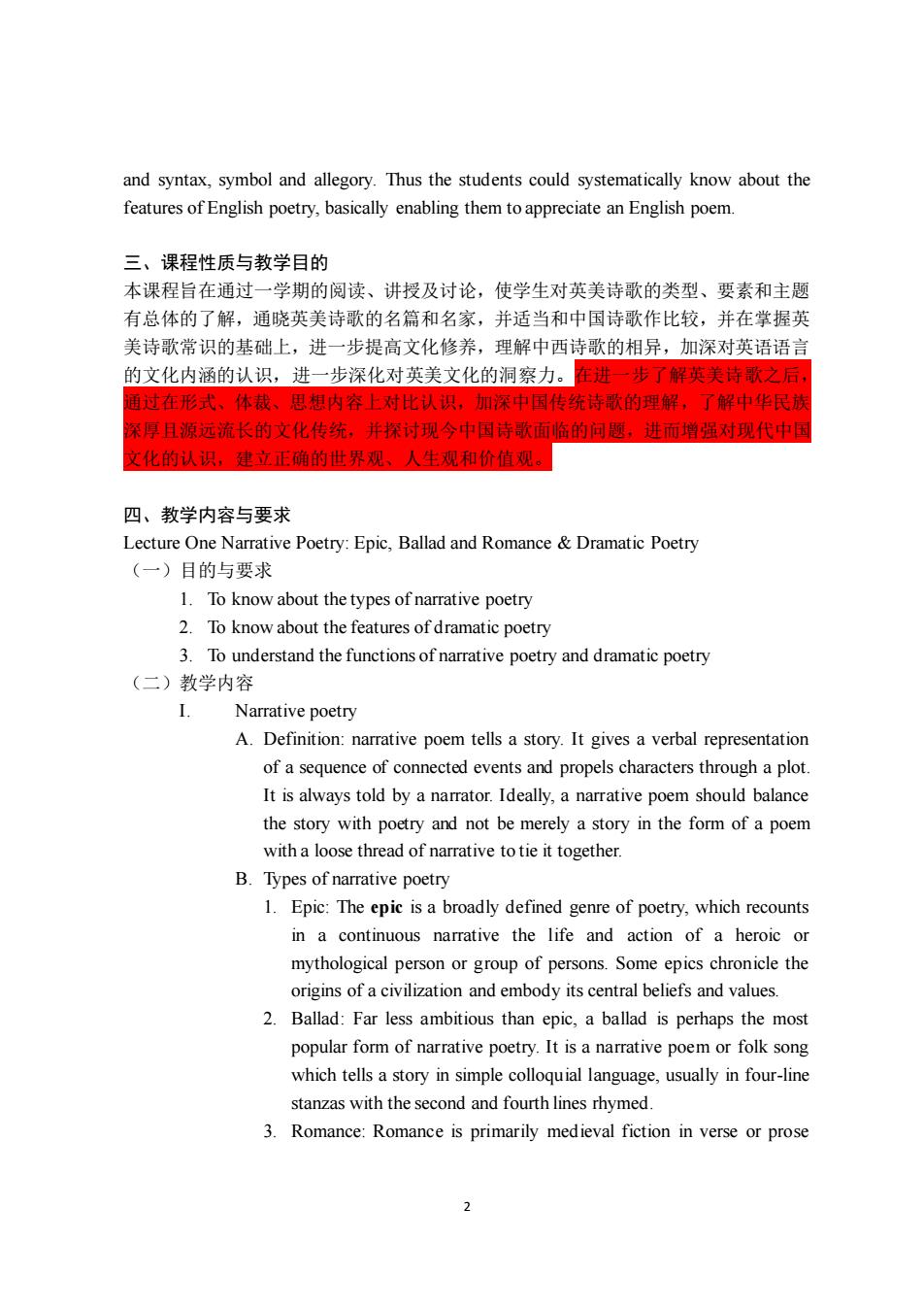
and syntax,symbol and allegory.Thus the students could systematically know about the features of English poetry,basically enabling them to appreciate an English poem. 三、课程性质与教学目的 本课程旨在通过一学期的阅读、讲授及讨论,使学生对英美诗歌的类型、要素和主题 有总体的了解,通晓英美诗歌的名篇和名家,并适当和中国诗歌作比较,并在掌握英 美诗歌常识的基础上,进一步提高文化修养,理解中西诗歌的相异,加深对英语语言 的文化内涵的认识,进一步深化对英美文化的洞察力。在进一步了解爽美诗歌之后 通过在形式体排、思相内容上过比以迎,加室中面传经诗的硬醒,了解中华民 莱厚且源远流长的文化传统,并探讨现今中国诗歌面临的问题,进而增强对现代中国 文化的认识,建立正确的世界观、人生观和价值观。 四、教学内容与要求 Lecture One Narrative Poetry:Epic,Ballad and Romance Dramatic Poetry (一)目的与要求 1.To know about the types of narrative poetry 2.To know about the features of dramatic poetry 3.To understand the functions of narrative poetry and dramatic poetry (二)教学内容 Narrative poetry A.Definition:narrative poem tells a story.It gives a verbal representation of a sequence of connected events and propels characters through a plot. It is always told by a narrator.Ideally,a narrative poem should balance the story with poetry and not be merely a story in the form of a poem with a loose thread of narrative to tie it together. B.Types of narrative poetry 1.Epic:The epic is a broadly defined genre of poetry,which recounts in a continuous narrative the life and action of a heroic or mythological person or group of persons.Some epics chronicle the origins of a civilization and embody its central beliefs and values. 2.Ballad:Far less ambitious than epic,a ballad is perhaps the most popular form of narrative poetry.It is a narrative poem or folk song which tells a story in simple colloquial language,usually in four-line stanzas with the second and fourth lines rhymed 3.Romance:Romance is primarily medieval fiction in verse or prose 2
2 and syntax, symbol and allegory. Thus the students could systematically know about the features of English poetry, basically enabling them to appreciate an English poem. 三、课程性质与教学目的 本课程旨在通过一学期的阅读、讲授及讨论,使学生对英美诗歌的类型、要素和主题 有总体的了解,通晓英美诗歌的名篇和名家,并适当和中国诗歌作比较,并在掌握英 美诗歌常识的基础上,进一步提高文化修养,理解中西诗歌的相异,加深对英语语言 的文化内涵的认识,进一步深化对英美文化的洞察力。在进一步了解英美诗歌之后, 通过在形式、体裁、思想内容上对比认识,加深中国传统诗歌的理解,了解中华民族 深厚且源远流长的文化传统,并探讨现今中国诗歌面临的问题,进而增强对现代中国 文化的认识,建立正确的世界观、人生观和价值观。 四、教学内容与要求 Lecture One Narrative Poetry: Epic, Ballad and Romance & Dramatic Poetry (一)目的与要求 1. To know about the types of narrative poetry 2. To know about the features of dramatic poetry 3. To understand the functions of narrative poetry and dramatic poetry (二)教学内容 I. Narrative poetry A. Definition: narrative poem tells a story. It gives a verbal representation of a sequence of connected events and propels characters through a plot. It is always told by a narrator. Ideally, a narrative poem should balance the story with poetry and not be merely a story in the form of a poem with a loose thread of narrative to tie it together. B. Types of narrative poetry 1. Epic: The epic is a broadly defined genre of poetry, which recounts in a continuous narrative the life and action of a heroic or mythological person or group of persons. Some epics chronicle the origins of a civilization and embody its central beliefs and values. 2. Ballad: Far less ambitious than epic, a ballad is perhaps the most popular form of narrative poetry. It is a narrative poem or folk song which tells a story in simple colloquial language, usually in four-line stanzas with the second and fourth lines rhymed. 3. Romance: Romance is primarily medieval fiction in verse or prose
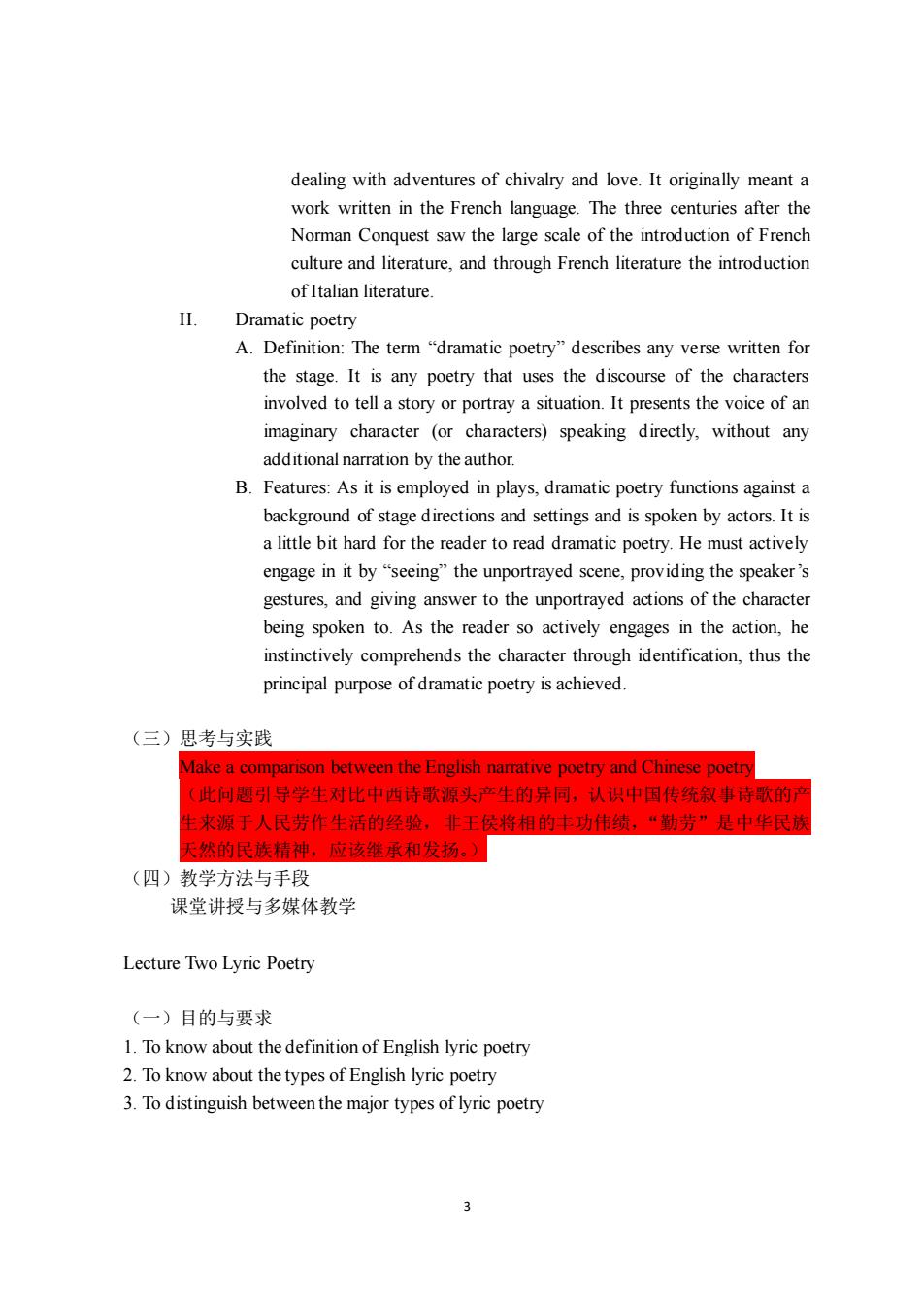
dealing with adventures of chivalry and love.It originally meant a work written in the French language.The three centuries after the Norman Conquest saw the large scale of the introduction of French culture and literature,and through French literature the introduction of Italian literature. Dramatic poetry A.Definition:The term "dramatic poetry"describes any verse written for the stage.It is any poetry that uses the discourse of the characters involved to tell a story or portray a situation.It presents the voice of an imaginary character (or characters)speaking directly,without any additional narration by the author. B.Features:As it is employed in plays,dramatic poetry functions against a background of stage directions and settings and is spoken by actors.It is a little bit hard for the reader to read dramatic poetry.He must actively engage in it by"seeing"the unportrayed scene,providing the speaker's gestures,and giving answer to the unportrayed actions of the character being spoken to.As the reader so actively engages in the action,he instinctively comprehends the character through identification,thus the principal purpose of dramatic poetry is achieved (三)思考与实践 Make a comparison between the English narrative poetry and Chinese poetry (此问引导学生对比中西诗歌源头产生的异同,认识中国传统叙事诗数的 生表源于人民劳作生活的经验,非王侯将相的丰功伟绩,“勤劳”是中华民 天然的民族精神 应该练承和发扬。 (四)教学方法与手段 课堂讲授与多媒体教学 Lecture Two Lyric Poetry (一)目的与要求 1.To know about the definition of English lyric poetry 2.To know about the types of English lyric poetry 3.To distinguish between the major types of lyric poetry
3 dealing with adventures of chivalry and love. It originally meant a work written in the French language. The three centuries after the Norman Conquest saw the large scale of the introduction of French culture and literature, and through French literature the introduction of Italian literature. II. Dramatic poetry A. Definition: The term “dramatic poetry” describes any verse written for the stage. It is any poetry that uses the discourse of the characters involved to tell a story or portray a situation. It presents the voice of an imaginary character (or characters) speaking directly, without any additional narration by the author. B. Features: As it is employed in plays, dramatic poetry functions against a background of stage directions and settings and is spoken by actors. It is a little bit hard for the reader to read dramatic poetry. He must actively engage in it by “seeing” the unportrayed scene, providing the speaker’s gestures, and giving answer to the unportrayed actions of the character being spoken to. As the reader so actively engages in the action, he instinctively comprehends the character through identification, thus the principal purpose of dramatic poetry is achieved. (三)思考与实践 Make a comparison between the English narrative poetry and Chinese poetry (此问题引导学生对比中西诗歌源头产生的异同,认识中国传统叙事诗歌的产 生来源于人民劳作生活的经验,非王侯将相的丰功伟绩,“勤劳”是中华民族 天然的民族精神,应该继承和发扬。) (四)教学方法与手段 课堂讲授与多媒体教学 Lecture Two Lyric Poetry (一)目的与要求 1. To know about the definition of English lyric poetry 2. To know about the types of English lyric poetry 3. To distinguish between the major types of lyric poetry
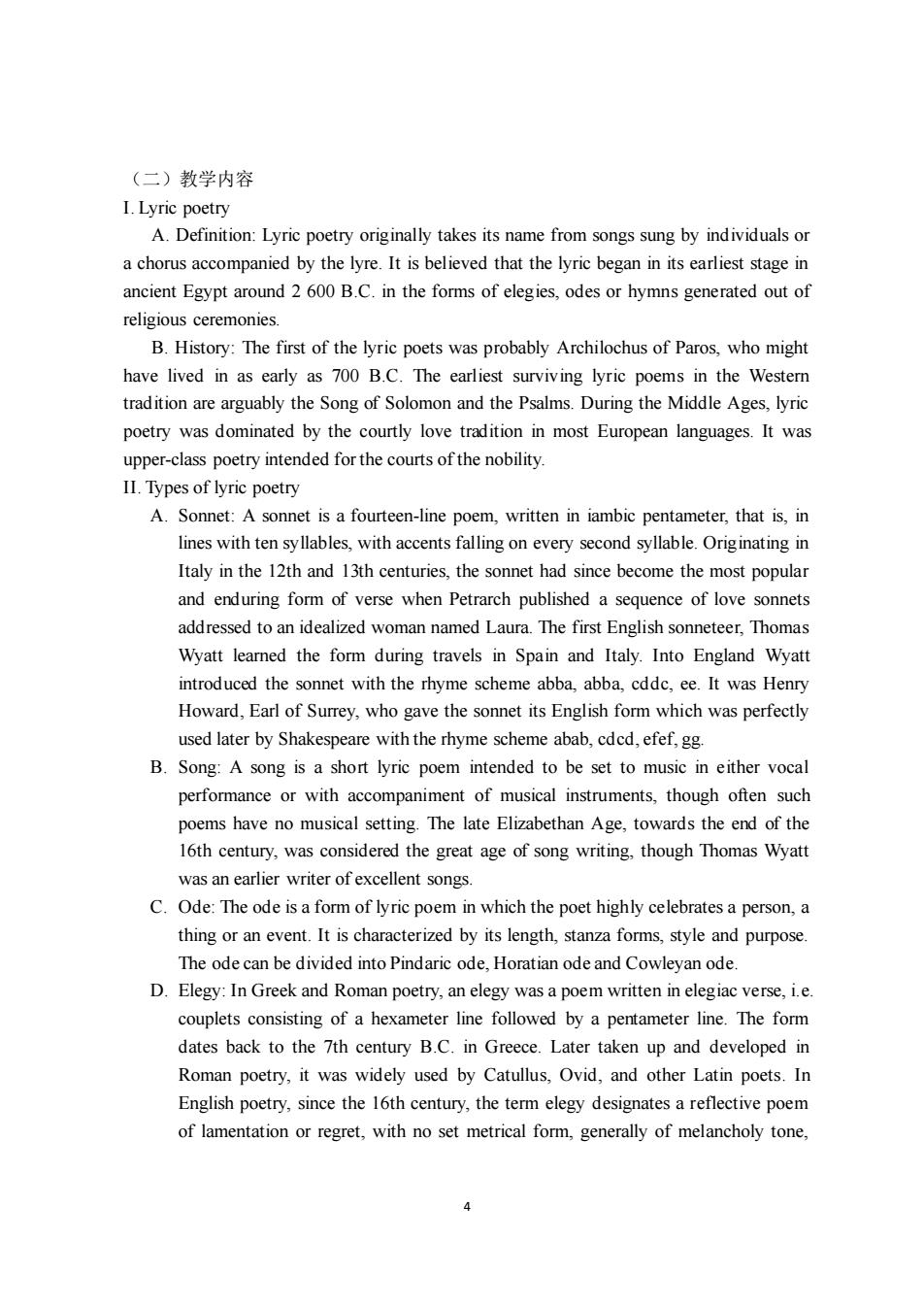
(二)教学内容 I.Lyric poetry A.Definition:Lyric poetry originally takes its name from songs sung by individuals or a chorus accompanied by the lyre.It is believed that the lyric began in its earliest stage in ancient Egypt around 2 600 B.C.in the forms of elegies,odes or hymns generated out of religious ceremonies. B.History:The first of the lyric poets was probably Archilochus of Paros,who might have lived in as early as 700 B.C.The earliest surviving lyric poems in the Western tradition are arguably the Song of Solomon and the Psalms.During the Middle Ages,lyric poetry was dominated by the courtly love tradition in most European languages.It was upper-class poetry intended for the courts ofthe nobility. II.Types of lyric poetry A.Sonnet:A sonnet is a fourteen-line poem,written in iambic pentameter,that is,in lines with ten syllables,with accents falling on every second syllable.Originating in Italy in the 12th and 13th centuries,the sonnet had since become the most popular and enduring form of verse when Petrarch published a sequence of love sonnets addressed to an idealized woman named Laura.The first English sonneteer.Thomas Wyatt learned the form during travels in Spain and Italy.Into England Wyatt introduced the sonnet with the rhyme scheme abba,abba,cddc,ee.It was Henry Howard,Earl of Surrey,who gave the sonnet its English form which was perfectly used later by Shakespeare with the rhyme scheme abab,cded,efef,gg. B.Song:A song is a short lyric poem intended to be set to music in either vocal performance or with accompaniment of musical instruments,though often such poems have no musical setting.The late Elizabethan Age,towards the end of the 16th century,was considered the great age of song writing.though Thomas Wyatt was an earlier writer of excellent songs C.Ode:The ode is a form of lyric poem in which the poet highly celebrates a person,a thing or an event.It is characterized by its length,stanza forms,style and purpose. The ode can be divided into Pindaric ode.Horatian ode and Cowleyan ode. D.Elegy:In Greek and Roman poetry,an elegy was a poem written in elegiac verse,i.e. couplets consisting of a hexameter line followed by a pentameter line.The form dates back to the 7th century B.C.in Greece.Later taken up and developed in Roman poetry,it was widely used by Catullus,Ovid,and other Latin poets.In English poetry.since the 16th century,the term elegy designates a reflective poem of lamentation or regret,with no set metrical form,generally of melancholy tone, 4
4 (二)教学内容 I. Lyric poetry A. Definition: Lyric poetry originally takes its name from songs sung by individuals or a chorus accompanied by the lyre. It is believed that the lyric began in its earliest stage in ancient Egypt around 2 600 B.C. in the forms of elegies, odes or hymns generated out of religious ceremonies. B. History: The first of the lyric poets was probably Archilochus of Paros, who might have lived in as early as 700 B.C. The earliest surviving lyric poems in the Western tradition are arguably the Song of Solomon and the Psalms. During the Middle Ages, lyric poetry was dominated by the courtly love tradition in most European languages. It was upper-class poetry intended for the courts of the nobility. II. Types of lyric poetry A. Sonnet: A sonnet is a fourteen-line poem, written in iambic pentameter, that is, in lines with ten syllables, with accents falling on every second syllable. Originating in Italy in the 12th and 13th centuries, the sonnet had since become the most popular and enduring form of verse when Petrarch published a sequence of love sonnets addressed to an idealized woman named Laura. The first English sonneteer, Thomas Wyatt learned the form during travels in Spain and Italy. Into England Wyatt introduced the sonnet with the rhyme scheme abba, abba, cddc, ee. It was Henry Howard, Earl of Surrey, who gave the sonnet its English form which was perfectly used later by Shakespeare with the rhyme scheme abab, cdcd, efef, gg. B. Song: A song is a short lyric poem intended to be set to music in either vocal performance or with accompaniment of musical instruments, though often such poems have no musical setting. The late Elizabethan Age, towards the end of the 16th century, was considered the great age of song writing, though Thomas Wyatt was an earlier writer of excellent songs. C. Ode: The ode is a form of lyric poem in which the poet highly celebrates a person, a thing or an event. It is characterized by its length, stanza forms, style and purpose. The ode can be divided into Pindaric ode, Horatian ode and Cowleyan ode. D. Elegy: In Greek and Roman poetry, an elegy was a poem written in elegiac verse, i.e. couplets consisting of a hexameter line followed by a pentameter line. The form dates back to the 7th century B.C. in Greece. Later taken up and developed in Roman poetry, it was widely used by Catullus, Ovid, and other Latin poets. In English poetry, since the 16th century, the term elegy designates a reflective poem of lamentation or regret, with no set metrical form, generally of melancholy tone
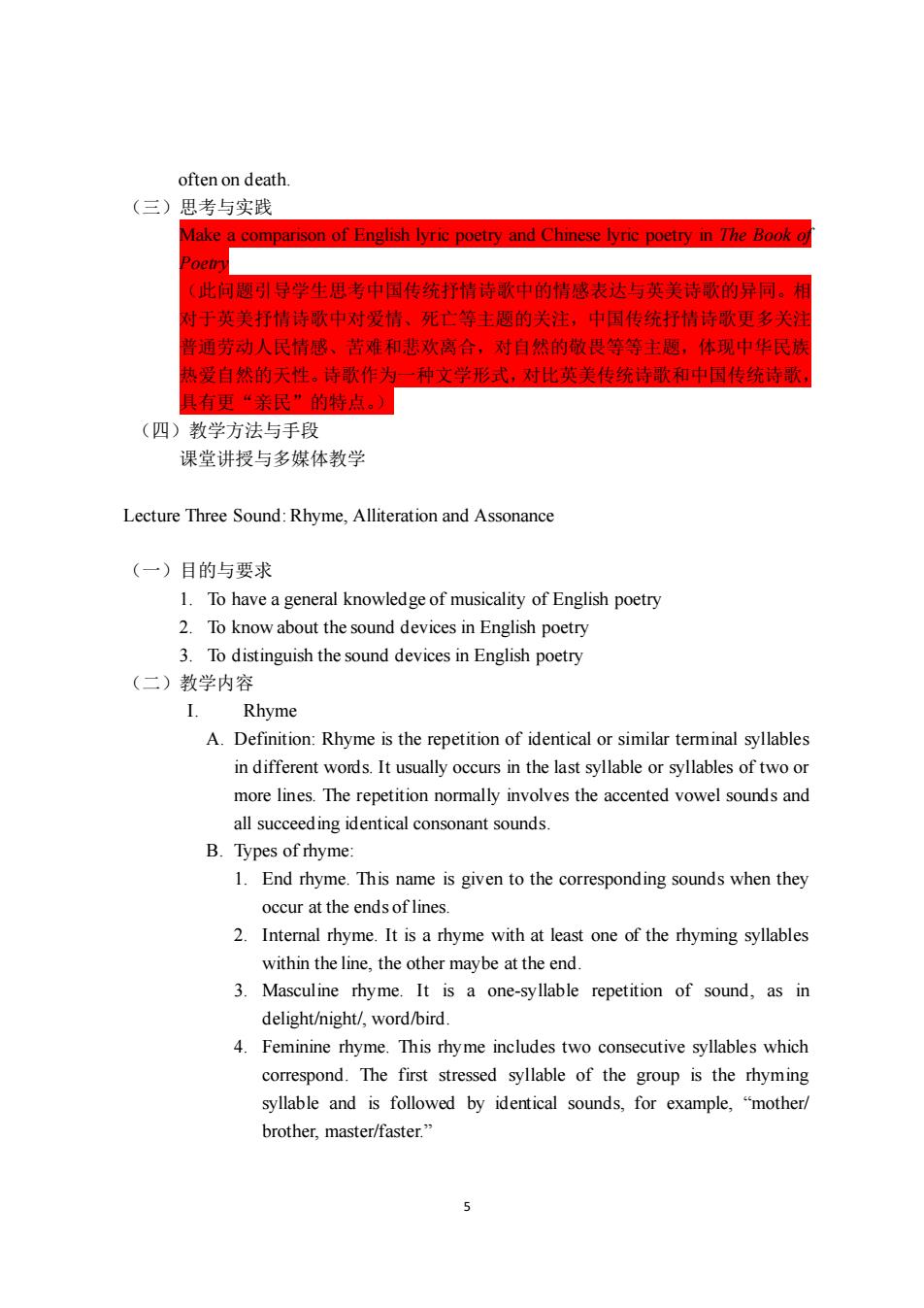
often on death. (三)思考与实践 Make a comparson of English lyric poetry and Chinese lyric poetry in The Book of (此问题引导学生思专中国传统抒情诗歌中的情感表达与英美诗歌的异同。有 付于英美抒情诗歌中对爱情、死亡等主恩的关注,中国传统抒情诗歌更多关 普通劳动人民情感、苦难和悲欢离合,对自然的放畏等等生题,体现中华民。 热爱自然的天性。诗歌作 种文学形式,对比英关传统诗歌和中国传统诗歌 具有更“亲民”的特点。 (四)教学方法与手段 课堂讲授与多媒体教学 Lecture Three Sound:Rhyme,Alliteration and Assonance (一)目的与要求 1.To have a general knowledge of musicality of English poetry 2.To know about the sound devices in English poetry 3.To distinguish the sound devices in English poetry (二)教学内容 Rhyme A.Definition:Rhyme is the repetition of identical or similar terminal syllables in different words.It usually occurs in the last syllable or syllables of two or more lines.The repetition normally involves the accented vowel sounds and all succeed ing identical consonant sounds. B.Types of rhyme 1.End rhyme.This name is given to the corresponding sounds when they occur at the endsof lines 2.Internal rhyme.It is a rhyme with at least one of the rhyming syllables within the line,the other maybe at the end. 3.Masculine rhyme.It is a one-syllable repetition of sound,as in delight/night/,word/bird. 4.Feminine rhyme.This rhyme includes two consecutive syllables which correspond.The first stressed syllable of the group is the rhyming syllable and is followed by identical sounds,for example,"mother/ brother.master/faster
5 often on death. (三)思考与实践 Make a comparison of English lyric poetry and Chinese lyric poetry in The Book of Poetry (此问题引导学生思考中国传统抒情诗歌中的情感表达与英美诗歌的异同。相 对于英美抒情诗歌中对爱情、死亡等主题的关注,中国传统抒情诗歌更多关注 普通劳动人民情感、苦难和悲欢离合,对自然的敬畏等等主题,体现中华民族 热爱自然的天性。诗歌作为一种文学形式,对比英美传统诗歌和中国传统诗歌, 具有更“亲民”的特点。) (四)教学方法与手段 课堂讲授与多媒体教学 Lecture Three Sound: Rhyme, Alliteration and Assonance (一)目的与要求 1. To have a general knowledge of musicality of English poetry 2. To know about the sound devices in English poetry 3. To distinguish the sound devices in English poetry (二)教学内容 I. Rhyme A. Definition: Rhyme is the repetition of identical or similar terminal syllables in different words. It usually occurs in the last syllable or syllables of two or more lines. The repetition normally involves the accented vowel sounds and all succeeding identical consonant sounds. B. Types of rhyme: 1. End rhyme. This name is given to the corresponding sounds when they occur at the ends of lines. 2. Internal rhyme. It is a rhyme with at least one of the rhyming syllables within the line, the other maybe at the end. 3. Masculine rhyme. It is a one-syllable repetition of sound, as in delight/night/, word/bird. 4. Feminine rhyme. This rhyme includes two consecutive syllables which correspond. The first stressed syllable of the group is the rhyming syllable and is followed by identical sounds, for example, “mother/ brother, master/faster
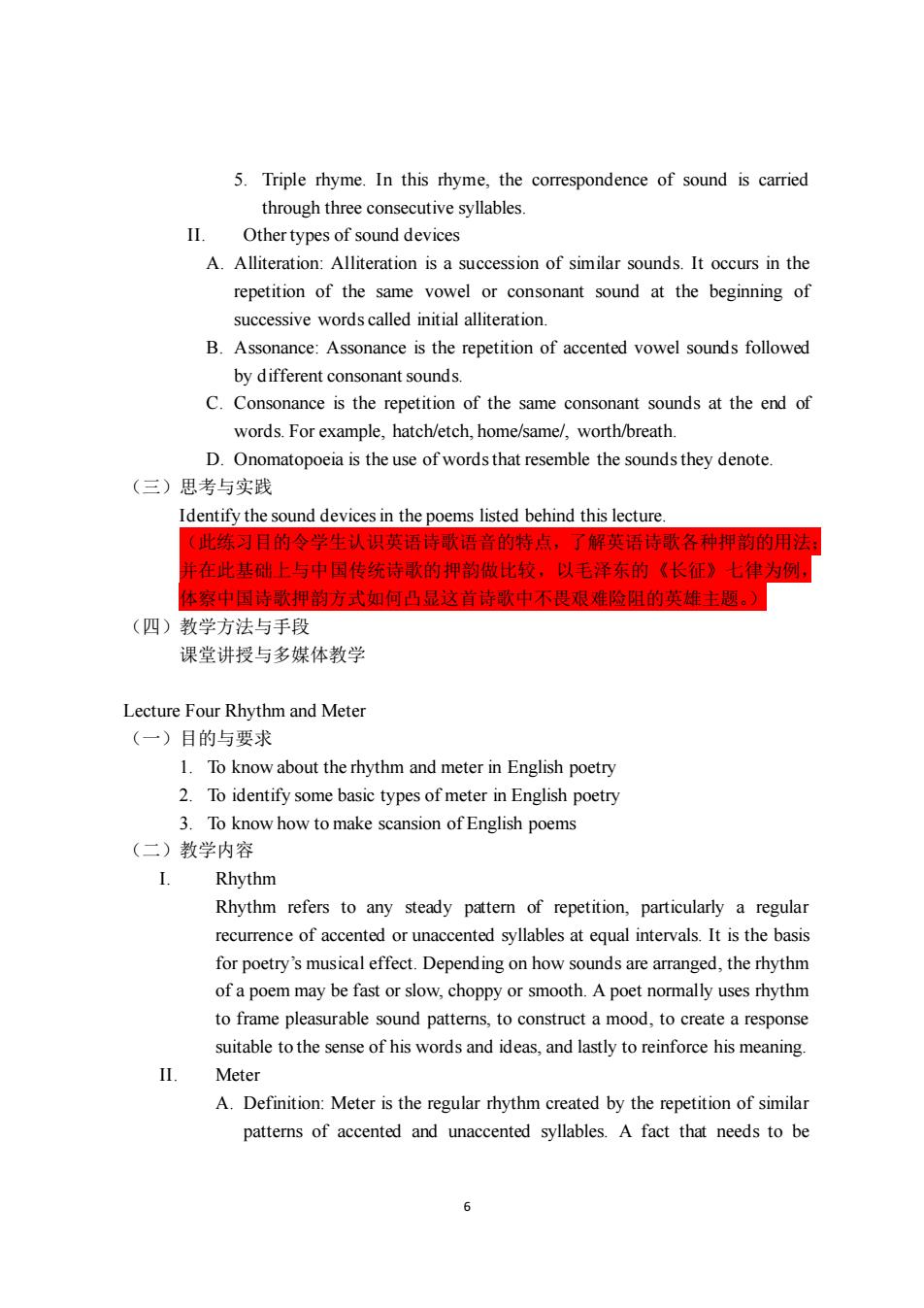
5.Triple rhyme.In this rhyme,the correspondence of sound is carried through three consecutive syllables II.Other types of sound devices A.Alliteration:Alliteration is a succession of similar sounds.It occurs in the repetition of the same vowel or consonant sound at the beginning of successive words called initial alliteration. B.Assonance:Assonance is the repetition of accented vowel sounds followed by different consonant sounds. C.Consonance is the repetition of the same consonant sounds at the end of words.For example,hatch/etch,home/same/,worth/breath. D.Onomatopoeia is the use of wordsthat resemble the sounds they denote (三)思考与实践 Identify the sound devices in the poems listed behind this lecture (此练习日的令学生认识英语诗版语音的特点,了解英语诗歌各种押韵的用法 并在此基础上与中国传统诗歌的押韵做比较,以毛泽东的《长征》七律为圆 体察中国诗歌押韵方式如何凸显这首诗数中不畏很难险阻的英雄士题。) (四)教学方法与手段 课堂讲授与多媒体教学 Lecture Four Rhythm and Meter (一)目的与要求 1.To know about the rhythm and meter in English poetry 2.To identify some basic types of meter in English poetry 3.To know how to make scansion of english poems (二)教学内容 Rhythm Rhythm refers to any steady pattem of repetition,particularly a regular recurrence of accented or unaccented syllables at equal intervals.It is the basis for poetry's musical effect,Depending on how sounds are arranged,the rhythm of a poem may be fast or slow,choppy or smooth.A poet normally uses rhythm to frame pleasurable sound patterns,to construct a mood,to create a response suitable to the sense of his words and ideas,and lastly to reinforce his meaning Meter A.Definition:Meter is the regular rhythm created by the repetition of similar patterns of accented and unaccented syllables.A fact that needs to be 6
6 5. Triple rhyme. In this rhyme, the correspondence of sound is carried through three consecutive syllables. II. Other types of sound devices A. Alliteration: Alliteration is a succession of similar sounds. It occurs in the repetition of the same vowel or consonant sound at the beginning of successive words called initial alliteration. B. Assonance: Assonance is the repetition of accented vowel sounds followed by different consonant sounds. C. Consonance is the repetition of the same consonant sounds at the end of words. For example, hatch/etch, home/same/, worth/breath. D. Onomatopoeia is the use of words that resemble the sounds they denote. (三)思考与实践 Identify the sound devices in the poems listed behind this lecture. (此练习目的令学生认识英语诗歌语音的特点,了解英语诗歌各种押韵的用法; 并在此基础上与中国传统诗歌的押韵做比较,以毛泽东的《长征》七律为例, 体察中国诗歌押韵方式如何凸显这首诗歌中不畏艰难险阻的英雄主题。) (四)教学方法与手段 课堂讲授与多媒体教学 Lecture Four Rhythm and Meter (一)目的与要求 1. To know about the rhythm and meter in English poetry 2. To identify some basic types of meter in English poetry 3. To know how to make scansion of English poems (二)教学内容 I. Rhythm Rhythm refers to any steady pattern of repetition, particularly a regular recurrence of accented or unaccented syllables at equal intervals. It is the basis for poetry’s musical effect. Depending on how sounds are arranged, the rhythm of a poem may be fast or slow, choppy or smooth. A poet normally uses rhythm to frame pleasurable sound patterns, to construct a mood, to create a response suitable to the sense of his words and ideas, and lastly to reinforce his meaning. II. Meter A. Definition: Meter is the regular rhythm created by the repetition of similar patterns of accented and unaccented syllables. A fact that needs to be
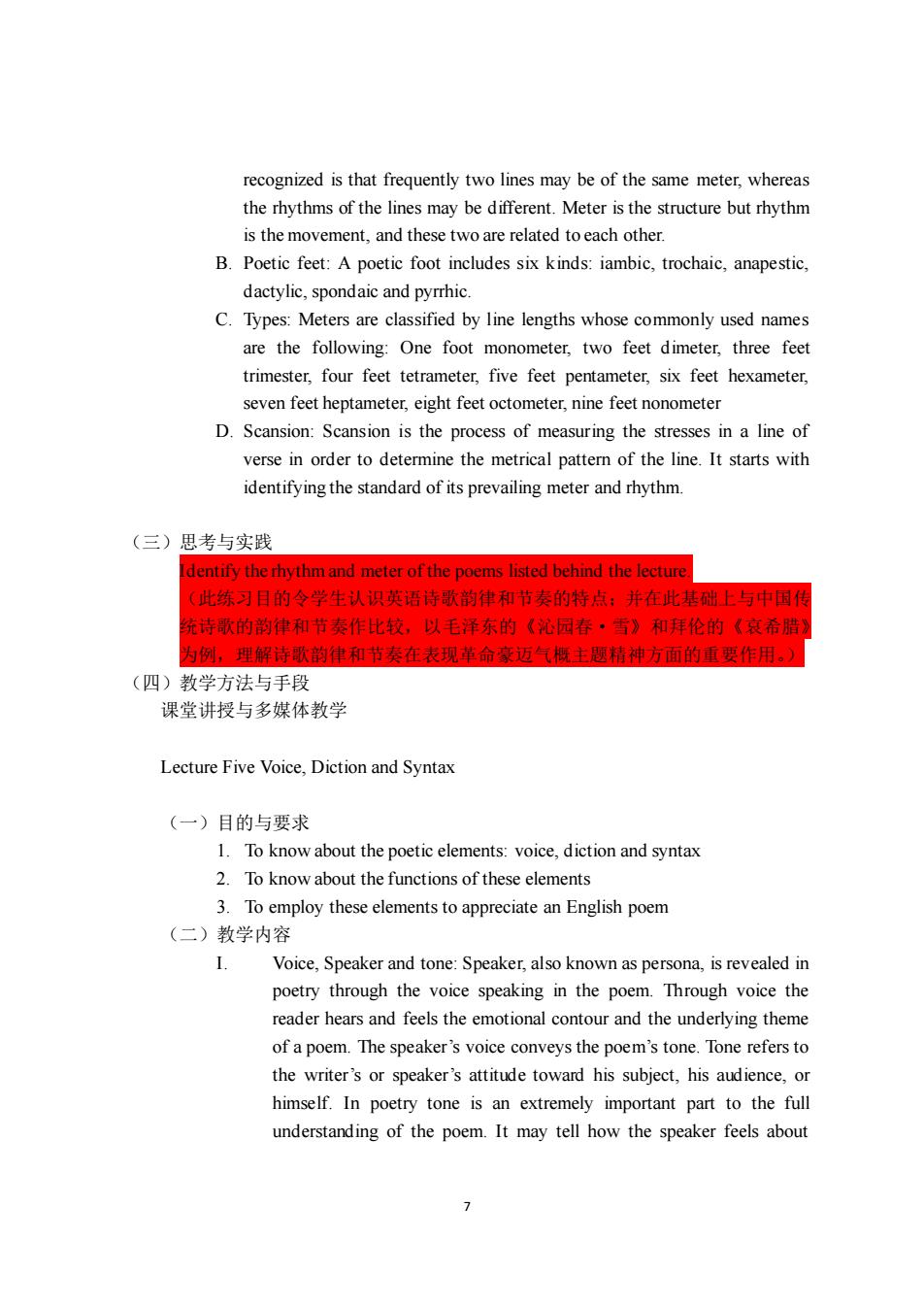
recognized is that frequently two lines may be of the same meter,whereas the rhythms of the lines may be different.Meter is the structure but rhythm is the movement,and these two are related to each other. B.Poetic feet:A poetic foot includes six kinds:iambic.trochaic.anapestic dactylic.spondaic and pyrrhic. C.Types:Meters are classified by line lengths whose commonly used names are the following:One foot monometer,two feet dimeter,three feet trimester,four feet tetrameter,five feet pentameter,six feet hexameter, seven feet heptameter,eight feet octometer,nine feet nonometer D.Scansion:Scansion is the process of measuring the stresses in a line of verse in order to determine the metrical pattern of the line.It starts with identifying the standard of its prevailing meter and rhythm. (三)思考与实践 Identify the rhythm and meter of the poems listed behind the lecture (此练习目的令学生认识英语诗歌韵律和节奏的特点:并在此基础上与中国 充诗歌的韵律和节奏作比较,以毛洋东的《沁园春·雪》和拜伦的《夜希 为例,理解诗歌韵律和节奏在表现革命豪迈气概丰题精神方面的重要作用。 (四)教学方法与手段 课堂讲授与多媒体教学 Lecture Five Voice,Diction and Syntax (一)目的与要求 1.To know about the poetic elements:voice,diction and syntax 2.To know about the functions of these elements 3.To employ these elements to appreciate an English poem (二)教学内容 Voice,Speaker and tone:Speaker,also known as persona,is revealed in poetry through the voice speaking in the poem.Through voice the reader hears and feels the emotional contour and the underlying theme of a poem.The speaker's voice conveys the poem's tone.Tone refers to the writer's or speaker's attitude toward his subject,his audience.or himself.In poetry tone is an extremely important part to the full understanding of the poem.It may tell how the speaker feels about
7 recognized is that frequently two lines may be of the same meter, whereas the rhythms of the lines may be different. Meter is the structure but rhythm is the movement, and these two are related to each other. B. Poetic feet: A poetic foot includes six kinds: iambic, trochaic, anapestic, dactylic, spondaic and pyrrhic. C. Types: Meters are classified by line lengths whose commonly used names are the following: One foot monometer, two feet dimeter, three feet trimester, four feet tetrameter, five feet pentameter, six feet hexameter, seven feet heptameter, eight feet octometer, nine feet nonometer D. Scansion: Scansion is the process of measuring the stresses in a line of verse in order to determine the metrical pattern of the line. It starts with identifying the standard of its prevailing meter and rhythm. (三)思考与实践 Identify the rhythm and meter of the poems listed behind the lecture. (此练习目的令学生认识英语诗歌韵律和节奏的特点;并在此基础上与中国传 统诗歌的韵律和节奏作比较,以毛泽东的《沁园春·雪》和拜伦的《哀希腊》 为例,理解诗歌韵律和节奏在表现革命豪迈气概主题精神方面的重要作用。) (四)教学方法与手段 课堂讲授与多媒体教学 Lecture Five Voice, Diction and Syntax (一)目的与要求 1. To know about the poetic elements: voice, diction and syntax 2. To know about the functions of these elements 3. To employ these elements to appreciate an English poem (二)教学内容 I. Voice, Speaker and tone: Speaker, also known as persona, is revealed in poetry through the voice speaking in the poem. Through voice the reader hears and feels the emotional contour and the underlying theme of a poem. The speaker’s voice conveys the poem’s tone. Tone refers to the writer’s or speaker’s attitude toward his subject, his audience, or himself. In poetry tone is an extremely important part to the full understanding of the poem. It may tell how the speaker feels about
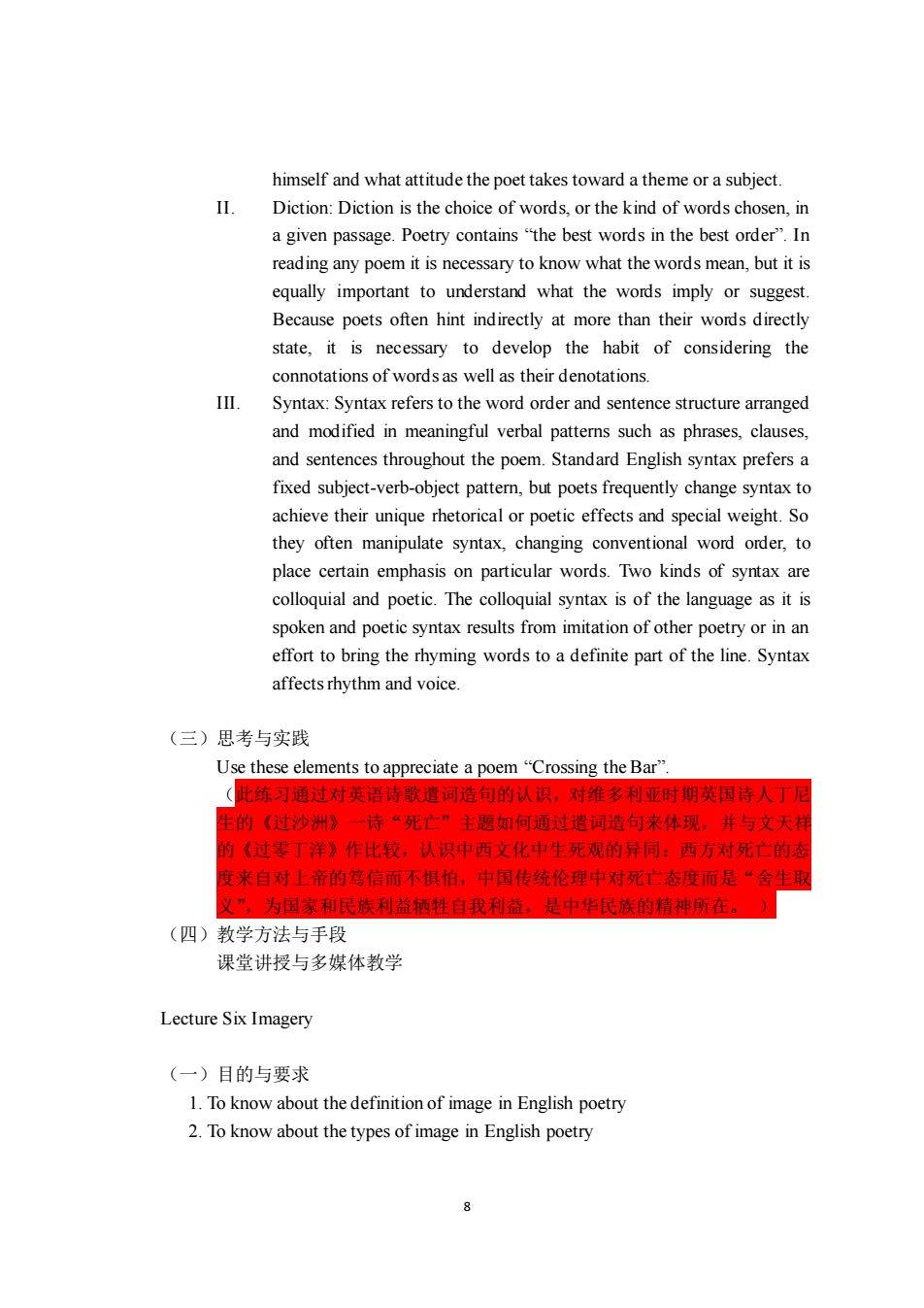
himself and what attitude the poet takes toward a theme or a subject. Diction:Diction is the choice of words,or the kind of words chosen,in a given passage.Poetry contains"the best words in the best order".In reading any poem it is necessary to know what the words mean,but it is equally important to understand what the words imply or suggest. Because poets often hint indirectly at more than their words directly state.it is necessary to develop the habit of considering the connotations of words as well as their denotations. Syntax:Syntax refers to the word order and sentence structure arranged and modified in meaningful verbal patterns such as phrases,clauses. and sentences throughout the poem.Standard English syntax prefers a fixed subject-verb-object pattern,but poets frequently change syntax to achieve their unique rhetorical or poetic effects and special weight.So they often manipulate syntax,changing conventional word order,to place certain emphasis on particular words.Two kinds of syntax are colloquial and poetic.The colloquial syntax is of the language as it is spoken and poetic syntax results from imitation of other poetry or in an effort to bring the rhyming words to a definite part of the line.Syntax affects rhythm and voice (三)思考与实践 Use these elements to appreciate a poem"Crossing the Bar" (此练习通过对英语诗歌道词造句的认识,对维多利亚时期英国诗人丁 生的《过沙洲》一诗“死亡”上题如何通过造词造句来体现,并与文天 的(过零丁洋》作比较,认识中西文化中生死观的异同:西方对死亡的 度来自对上帝的鹤信而不惧怕,中国传统伦理中付死亡态度而是“舍生 为国家和民族利益辆牲自我利益,是中华民族的精神所在。 (四)教学方法与手段 课堂讲授与多媒体教学 Lecture Six Imagery (一)目的与要求 1.To know about the definition of image in English poetry 2.To know about the types of image in English poetry
8 himself and what attitude the poet takes toward a theme or a subject. II. Diction: Diction is the choice of words, or the kind of words chosen, in a given passage. Poetry contains “the best words in the best order”. In reading any poem it is necessary to know what the words mean, but it is equally important to understand what the words imply or suggest. Because poets often hint indirectly at more than their words directly state, it is necessary to develop the habit of considering the connotations of words as well as their denotations. III. Syntax: Syntax refers to the word order and sentence structure arranged and modified in meaningful verbal patterns such as phrases, clauses, and sentences throughout the poem. Standard English syntax prefers a fixed subject-verb-object pattern, but poets frequently change syntax to achieve their unique rhetorical or poetic effects and special weight. So they often manipulate syntax, changing conventional word order, to place certain emphasis on particular words. Two kinds of syntax are colloquial and poetic. The colloquial syntax is of the language as it is spoken and poetic syntax results from imitation of other poetry or in an effort to bring the rhyming words to a definite part of the line. Syntax affects rhythm and voice. (三)思考与实践 Use these elements to appreciate a poem “Crossing the Bar”. (此练习通过对英语诗歌遣词造句的认识,对维多利亚时期英国诗人丁尼 生的《过沙洲》一诗“死亡”主题如何通过遣词造句来体现,并与文天祥 的《过零丁洋》作比较,认识中西文化中生死观的异同:西方对死亡的态 度来自对上帝的笃信而不惧怕,中国传统伦理中对死亡态度而是“舍生取 义”,为国家和民族利益牺牲自我利益,是中华民族的精神所在。 ) (四)教学方法与手段 课堂讲授与多媒体教学 Lecture Six Imagery (一)目的与要求 1. To know about the definition of image in English poetry 2. To know about the types of image in English poetry
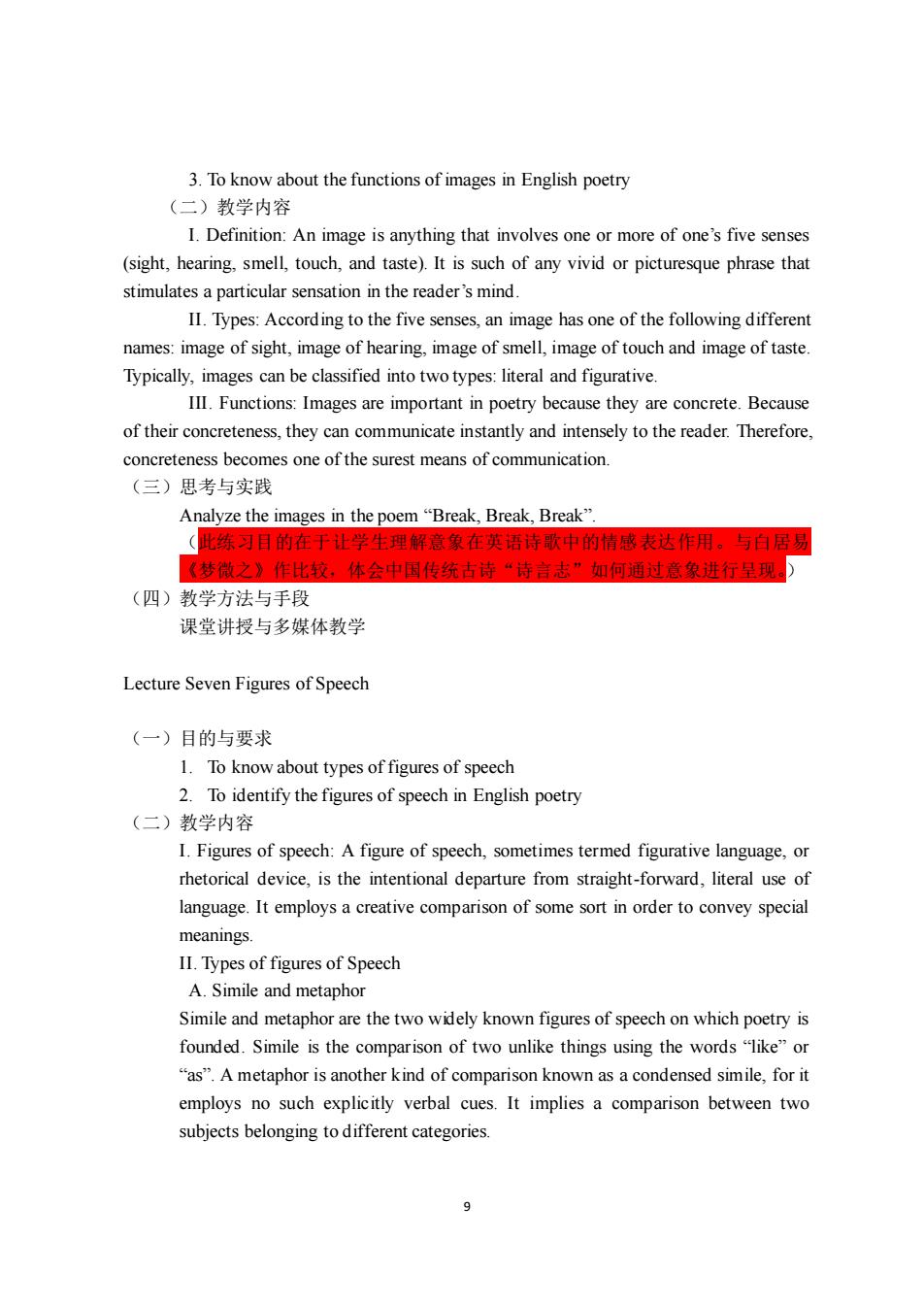
3.To know about the functions of images in English poetry (二)教学内容 I.Definition:An image is anything that involves one or more of one's five senses (sight,hearing.smell,touch,and taste).It is such of any vivid or picturesque phrase that stimulates a particular sensation in the reader's mind. II.Types:According to the five senses,an image has one of the following different names:image of sight,image of hearing.image of smell,image of touch and image of taste. Typically,images can be classified into two types:literal and figurative. III.Functions:Images are important in poetry because they are concrete.Because of their concreteness,they can communicate instantly and intensely to the reader.Therefore, concreteness becomes one of the surest means of communication. (三)思考与实践 Analyze the images in the poem"Break,Break,Break". (此练小目的在干让学生理解意象在英语诗歌中的情感表达作用。与自居 《梦微之》作比较。体会中国传统占诗“诗言志”如何通过意象进行现 (四)教学方法与手段 课堂讲授与多媒体教学 Lecture Seven Figures of Speech (一)目的与要求 1.To know about types of figures of speech 2.To identify the figures of speech in English poetry (二)教学内容 I.Figures of speech:A figure of speech,sometimes termed figurative language.or rhetorical device.is the intentional departure from straight-forward.literal use of language.It employs a creative comparison of some sort in order to convey special meanings II.Types of figures of Speech A.Simile and metaphor Simile and metaphor are the two widely known figures of speech on which poetry is founded.Simile is the comparison of two unlike things using the words"like"or "as.A metaphor is another kind of comparison known as a condensed simile,for it employs no such explicitly verbal cues.It implies a comparison between two subjects belonging to different categories
9 3. To know about the functions of images in English poetry (二)教学内容 I. Definition: An image is anything that involves one or more of one’s five senses (sight, hearing, smell, touch, and taste). It is such of any vivid or picturesque phrase that stimulates a particular sensation in the reader’s mind. II. Types: According to the five senses, an image has one of the following different names: image of sight, image of hearing, image of smell, image of touch and image of taste. Typically, images can be classified into two types: literal and figurative. III. Functions: Images are important in poetry because they are concrete. Because of their concreteness, they can communicate instantly and intensely to the reader. Therefore, concreteness becomes one of the surest means of communication. (三)思考与实践 Analyze the images in the poem “Break, Break, Break”. (此练习目的在于让学生理解意象在英语诗歌中的情感表达作用。与白居易 《梦微之》作比较,体会中国传统古诗“诗言志”如何通过意象进行呈现。) (四)教学方法与手段 课堂讲授与多媒体教学 Lecture Seven Figures of Speech (一)目的与要求 1. To know about types of figures of speech 2. To identify the figures of speech in English poetry (二)教学内容 I. Figures of speech: A figure of speech, sometimes termed figurative language, or rhetorical device, is the intentional departure from straight-forward, literal use of language. It employs a creative comparison of some sort in order to convey special meanings. II. Types of figures of Speech A. Simile and metaphor Simile and metaphor are the two widely known figures of speech on which poetry is founded. Simile is the comparison of two unlike things using the words “like” or “as”. A metaphor is another kind of comparison known as a condensed simile, for it employs no such explicitly verbal cues. It implies a comparison between two subjects belonging to different categories

B.Metonymy and Synecdoche Metonymy is a figure of speech in which one word or phrase is substituted for another to which it is closely related.It demands a comprehension on the part of the reader of ideas and objects that are closely and commonly related.Synecdoche is the use of the part of a thing to stand for the whole of it or vice versa. C.Irony To see a distinction between the poet and the words of a fictitious character is to be aware of irony:a manner of speaking that implies a discrepancy.If the mask says one thing and we sense that the writer is in fact saying something else,the writer has adopted an ironic point of view.There are three common types of irony:verbal irony,dramatic irony and irony of situation D.Paradox Paradox is a state of affairs which appears to be logically self-contradictory and yet contains a truth.As a figure of speech,paradox is a condensed statement.It may resolve the discrepancy E.Personification Personification is giving human traits including feelings,qualities,action,or characteristics to inanimate(nonhuman)objects such as things,colors,qualities or ideas.It is actually a subtype of metaphor,an implied comparison in which the figurative term of the comparison is always a human being. F.Apostrophe In apostrophe,the poet directly addresses someone absent or something nonliving as if it were present and living and could reply to what is being said.The similarity of these two figures of speech is that both are giving life and immediacy to one's language.More often than not,the poet uses apostrophe to announce a lofty and serious tone. (三)思考与实践 Point out the figures of speech used in the poem"She Dwelt Among the Untrodden Wavw (四)教学方法与手段 课堂进授与名媒体教 Lecture Eight Symbolism and Allegory 10
10 B. Metonymy and Synecdoche Metonymy is a figure of speech in which one word or phrase is substituted for another to which it is closely related. It demands a comprehension on the part of the reader of ideas and objects that are closely and commonly related. Synecdoche is the use of the part of a thing to stand for the whole of it or vice versa. C. Irony To see a distinction between the poet and the words of a fictitious character is to be aware of irony: a manner of speaking that implies a discrepancy. If the mask says one thing and we sense that the writer is in fact saying something else, the writer has adopted an ironic point of view. There are three common types of irony: verbal irony, dramatic irony and irony of situation. D. Paradox Paradox is a state of affairs which appears to be logically self-contradictory and yet contains a truth. As a figure of speech, paradox is a condensed statement. It may resolve the discrepancy. E. Personification Personification is giving human traits including feelings, qualities, action, or characteristics to inanimate (nonhuman) objects such as things, colors, qualities or ideas. It is actually a subtype of metaphor, an implied comparison in which the figurative term of the comparison is always a human being. F. Apostrophe In apostrophe, the poet directly addresses someone absent or something nonliving as if it were present and living and could reply to what is being said. The similarity of these two figures of speech is that both are giving life and immediacy to one’s language. More often than not, the poet uses apostrophe to announce a lofty and serious tone. (三)思考与实践 Point out the figures of speech used in the poem “She Dwelt Among the Untrodden Way” (四)教学方法与手段 课堂讲授与多媒体教学 Lecture Eight Symbolism and Allegory